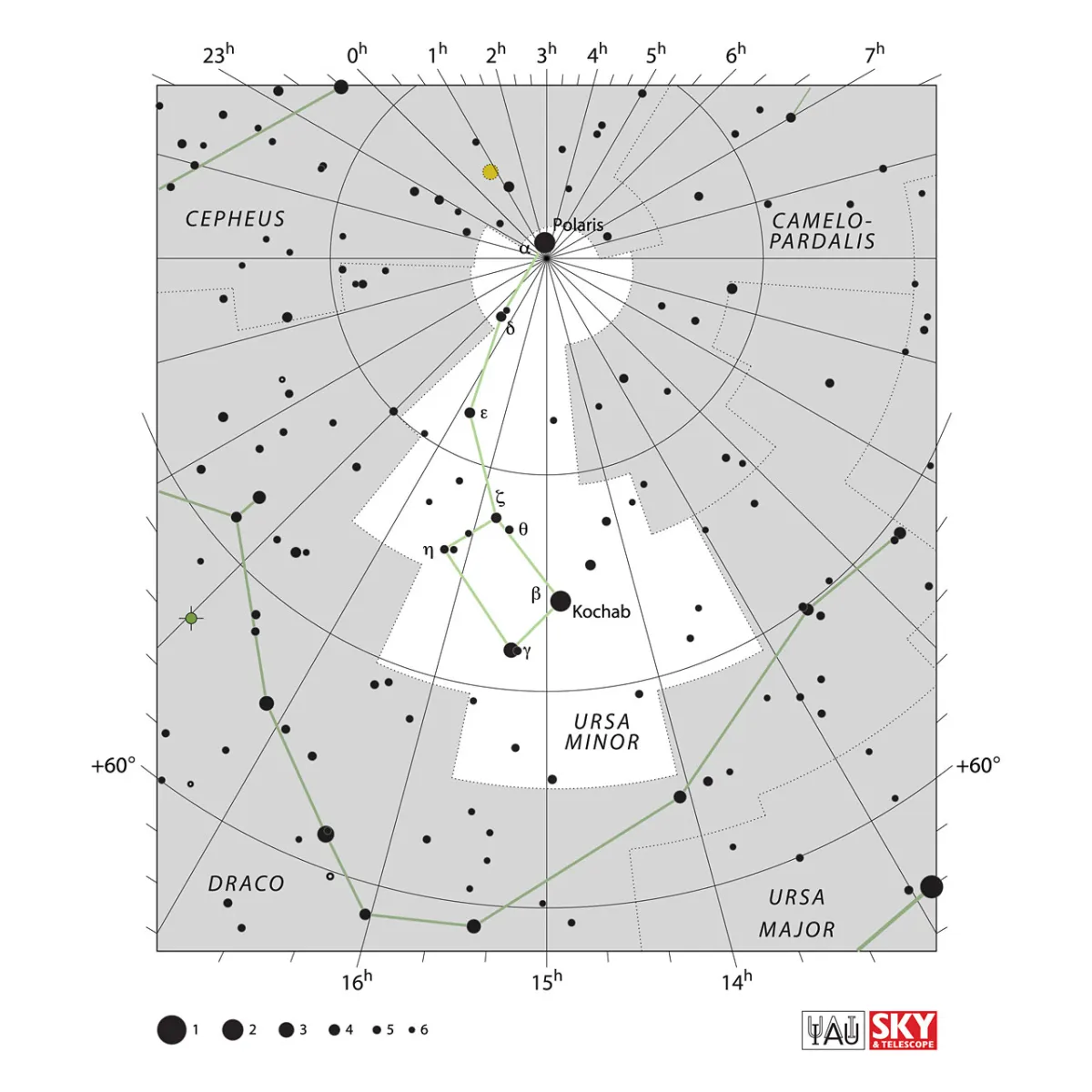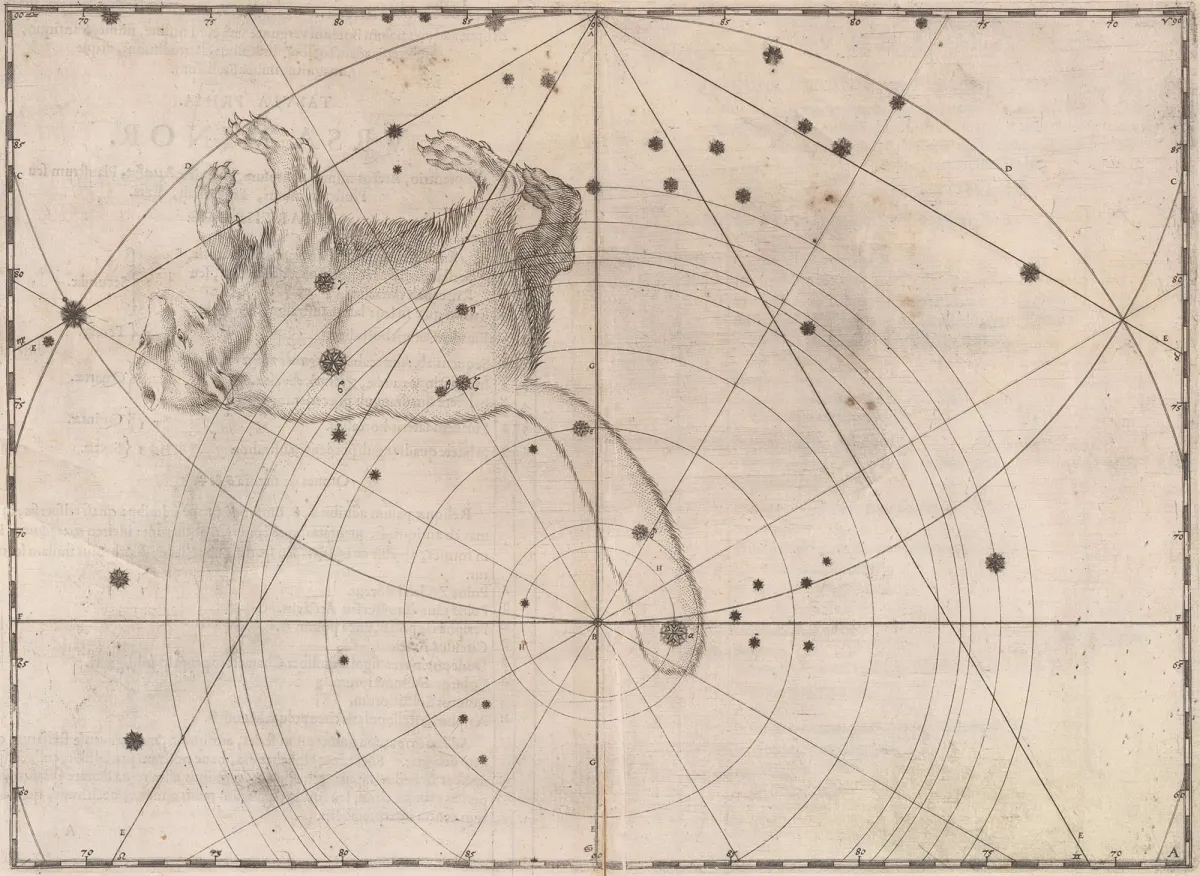Constellation Ursa Minor (Little Bear)

Properties
The constellation lies between Draco, Cepheus and Camelopardalis at the north celestial pole. This is currently only about 0.8° away from the bright star Polaris. Ursa Minor has roughly the same alignment as its larger relative Ursa Maior and is therefore easily recognizable. The area of the constellation is 256 square degrees and the centre culminates around midnight on 13 May. [9, 15]
| α UMi | Polaris, Alruccabah, Cynosura, Phoenice, Lodestar, Pole Star, Tramontana, Angel Stern, Navigatoria, Star Of Arcady, Yilduz, Mismar |
| β UMi | Kocab, Kochab, Kochah, "Guards Of The Pole |
| γ UMi | Pherkad, Pherkad Major |
| δ UMi | Yildun, Vildiur, Gildun |
| 11 UMi | Pherkad Minor |
| IAU Name | Ursa Minor |
| IAU Genitive | Ursae Minoris |
| IAU Abbr. | UMi |
| English Name | Little Bear |
| Culmination at local midnight | 11 May |
| Season (Latitude +0.0°) | January … October |
| Right Ascension (J2000.0) | 00h 00m 00s … 24h 00m 00s |
| Declination (J2000.0) | +65° 23' 59" … +90° 00' 00" |
| Area | 256 deg2 |
| Neighbours (N↻) | Cep, Cam, Dra |
Deep-Sky Object Descriptions
Catalogues
Determine the Visual Magnitude Limit

A "Wow!" night sky that is so clear and dark that the Milky Way runs from one horizon to the other and the space between the stars appears black and not blue has become rare. Sometimes there are only a few nights a year.
The quality of the night sky is mainly determined by the amount of water droplets and dust particles in the atmosphere; In addition, the sky is brightened by natural light (sun, moon, airglow) and artificial light (street lighting, advertising lighting, disco light shows). The higher the water and dust content in the atmosphere, the more susceptible it is to external lighting, as the light is scattered by these particles. This can be seen well at night in foggy car headlights and street lights.
The picture opposite shows Ursa Minor, as this constellation is visible all year round and is always about the same height in the sky. One waits until the eye is completely adapted to the dark (approx. After 30 minutes) and then tries to determine the weakest stars that are barely visible to the naked eye with the help of the map. If you look past the stars (indirect vision), you can still see those that cannot or can hardly be seen when looking directly at them.

Mythology and History
A part of the constellation Ursa Minor is likely to be at least Phoenician in origin and was used for navigation there. Until about 600 BC The constellation was not included in the group of Greek constellations and was therefore not mentioned by the Greek poets Homer and Hesiod. The Greek navigators used the Big Bear as a navigation aid. The constellation of the dragon was then more luxurious than we know it today, because the dragon had wings on the star alpha Draconis and was therefore particularly impressive according to its mythological meaning . The Greek philosopher Thales of Miletus regrouped the stars of the dragon's wings, creating a seven-star constellation that was very similar to the Big Dipper, except that it stood in the opposite direction in the sky. This so-called Little Dipper was a memorable navigation aid and therefore quickly caught on.
In addition to the names Ursa Minor, Little Bear and Little Carriage, there are also the names Ursa Phenicia and Phoenice has been used. The translation of the name "Little Bear" into the Arabic language led to the proper name Al Dubb al Asghar, which was used by the German astronomer Bayer Dhubb Elezguar and the English author Chilmead Dub Alasgar was written. The early Nordic cultures saw the Little Chariot or Thor's Throne in this constellation. [20]